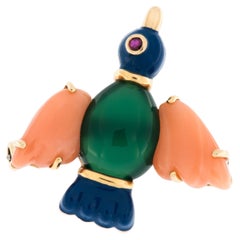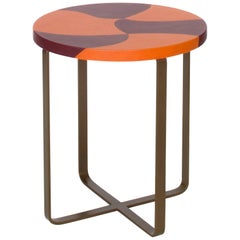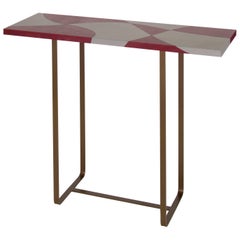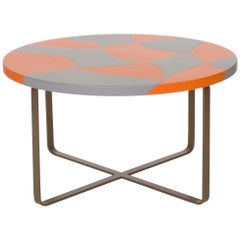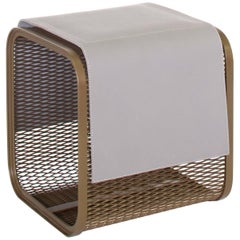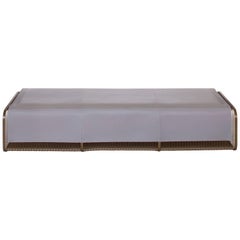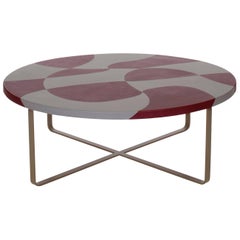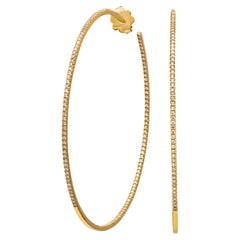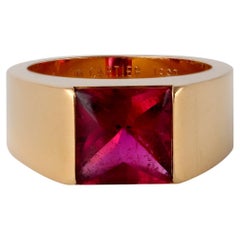Cartier Rose Colored Glasses
Brooch CARTIER Bird, Yellow Gold, Rose Coral, Chrysoprase, Ruby, Blue Enamel
By Cartier
Located in Esch-Sur-Alzette, LU
is a traditional jewelry technique that involves fusing colored glass onto metal, creating a smooth
Category
Late 20th Century French Artisan Brooches
Materials
Chrysophrase, Coral, Ruby, 18k Gold, Yellow Gold, Enamel
"Tiger" Inlaid Leather Top Side Table by Nestor Perkal for Oscar Maschera
By Oscar Maschera, Nestor Perkal
Located in Brooklyn, NY
exhibitions held at the Cartier Foundation (La vie en Roses, 1998), at the Galerie Chez Valentin, Paris (“chez
Category
21st Century and Contemporary Italian Modern Side Tables
Materials
Steel
"Flores" Inlaid Leather Top Console Table by Nestor Perkal for Oscar Maschera
By Oscar Maschera, Nestor Perkal
Located in Brooklyn, NY
has been the curator and scenographer of exhibitions held at the Cartier Foundation (La vie en Roses
Category
21st Century and Contemporary Italian Modern Console Tables
Materials
Steel
H 37.4 in W 47.5 in D 15.7 in
"Sur" Inlaid Leather Top Coffee Table by Nestor Perkal for Oscar Maschera
By Oscar Maschera, Nestor Perkal
Located in Brooklyn, NY
exhibitions held at the Cartier Foundation (La vie en Roses, 1998), at the Galerie Chez Valentin, Paris (“chez
Category
21st Century and Contemporary Italian Modern Coffee and Cocktail Tables
Materials
Steel
"Caballito Petit" Stool Designed by Nestor Perkal for Oscar Maschera
By Oscar Maschera, Nestor Perkal
Located in Brooklyn, NY
, featuring a structure in bronze colored steel mesh with high-integrity thermoset epoxy powder coating
Category
21st Century and Contemporary Italian Modern Stools
Materials
Steel
H 16.92 in W 15.74 in D 14.56 in
"Caballito Chaise Longue" Designed by Nestor Perkal for Oscar Maschera
By Oscar Maschera, Nestor Perkal
Located in Brooklyn, NY
structure in bronze colored steel mesh with high-integrity thermoset epoxy powder coating, padding in
Category
21st Century and Contemporary Italian Modern Chaise Longues
Materials
Steel
H 13.77 in W 72.83 in D 25.59 in
"Maupiti" Inlaid Leather Top Coffee Table by Nestor Perkal for Oscar Maschera
By Oscar Maschera, Nestor Perkal
Located in Brooklyn, NY
exhibitions held at the Cartier Foundation (La vie en Roses, 1998), at the Galerie Chez Valentin, Paris (“chez
Category
21st Century and Contemporary Italian Modern Coffee and Cocktail Tables
Materials
Steel
People Also Browsed
0.58 Carats Total Brilliant Round Cut Diamond Yellow Gold Large Hoop Earrings
Located in New York, NY
A fashionable and stunning large hoop earrings showcasing a row of 280 round brilliant diamonds, set inside and out in a traditional four prong setting weighing 0.58 carats total, F ...
Category
21st Century and Contemporary American Contemporary Hoop Earrings
Materials
Diamond, 18k Gold, Yellow Gold
Specchi Mirrors Set Designed by Nestor Perkal for Oscar Maschera
By Oscar Maschera, Nestor Perkal
Located in Brooklyn, NY
Set of seven hand mirrors which are in fact mounted on the wall. The softness of the leather makes it impossible for them to be held and forces us to hang them up, individually or to...
Category
21st Century and Contemporary Italian Wall Mirrors
Materials
Mirror
'Plissé White Edition' Pleated Textile Table Lamp by Folkform for Örsjö
By Örsjö Industri AB
Located in Glendale, CA
'Plissé White Edition' pleated textile table lamp by Folkform for Örsjö.
This unique table lamp was awarded “Lighting of the Year 2022” by Residence Magazine Sweden, who called it “...
Category
21st Century and Contemporary Swedish Mid-Century Modern Table Lamps
Materials
Textile
Organic Modern Small Table Lamp Natural Wood Handmade Fluted Shade
By Isabel Moncada
Located in San Antonio, TX
PATA DE ELEFANTE SMALL table lamp was designed for the Atomic collection by Mexican artist Isabel Moncada.
Named Pata de Elefante –Elephant's Foot– for the prominent shape at its ba...
Category
21st Century and Contemporary Mexican Mid-Century Modern Table Lamps
Materials
Textile, Wood
Organic Modern Floor Lamp Natural Wood Handmade Fluted Shade
By Isabel Moncada
Located in San Antonio, TX
PATA DE ELEFANTE floor lamp was designed for the Atomic collection by Mexican artist Isabel Moncada.
Named Pata de Elefante –Elephant‘s Foot– for the prominent shape at its base. Se...
Category
21st Century and Contemporary Mexican Mid-Century Modern Floor Lamps
Materials
Textile, Wood
JENNY Large Wall Light or Sconce in Enamel & Brass by Blueprint Lighting
By Blueprint Lighting, Mathieu Matégot, Stilnovo
Located in New York, NY
Introducing Jenny, the latest vintage-inspired fixture from Blueprint Lighting.
Named for multi-hyphenate Jenny Mollen; NYT best-selling author, actress, design enthusiast, mom of ...
Category
2010s American Mid-Century Modern Wall Lights and Sconces
Materials
Brass, Bronze, Enamel, Nickel
Large Counterbalance Ceiling Fixture, White Enamel + Brass by Blueprint Lighting
By Arteluce, Gino Sarfatti, Stilnovo
Located in New York, NY
Handcrafted and made to order, the Counterbalance commands attention with its fluid architectural silhouette, built from a thoughtfully curated palette of on-trend colors and metal f...
Category
2010s American Mid-Century Modern Chandeliers and Pendants
Materials
Brass, Bronze, Enamel, Chrome, Aluminum, Nickel
Stacked Bone and Brass Powder-Coated Table Lamp with Peekaboo Silver Leaf Shade
By Arvo Ray, Seth Premo
Located in Brooklyn, NY
The Junius lamp makes a bold statement with its geometric stacked elements that appear almost to float above one another. The lamp is constructed with a powder-coated steel shade and...
Category
2010s American Modern Table Lamps
Materials
Steel, Brass, Silver Leaf
H 18 in W 12 in D 12 in
Bulgari Diamond Ruby Gold Serpenti Necklace
By Bulgari
Located in New York, NY
Capturing the seductive and alluring quintessence of the Bulgari Serpent, this resplendent piece sinuously curves around the neck, with scales comprised of 18k yellow and white gold,...
Category
21st Century and Contemporary Italian Drop Necklaces
Materials
Diamond, Ruby, 18k Gold
Bombo "T" Pouf/Side Table Designed by Nestor Perkal for Oscar Maschera
By Oscar Maschera, Nestor Perkal
Located in Brooklyn, NY
First, there was an encounter between a designer,
Nestor Perkal, and the Oscarmaschera company. Then, there was
Argentina, his native land. While working with the company on
leather ...
Category
21st Century and Contemporary Italian Ottomans and Poufs
Materials
Leather
Contemporary Round Center Coffee Table in Wood Marquetry Black & White
Located in Porto, PT
Santiago Center Table celebrates the 20th-century art movement, Cubism, with handcraft expertise. Rough and natural materials approach us with an exact message: modest luxury. This a...
Category
21st Century and Contemporary Portuguese Modern Center Tables
Materials
Wood, Birdseye Maple
Belle Époque Diamond Tiara
Located in London, GB
A Belle Époque diamond tiara, to the centre three diamond-set clusters with diamond-set foliate decorations and one large diamond-set cluster on each side, all within a waved frame o...
Category
Early 20th Century French Belle Époque More Jewelry
Materials
Diamond, Platinum
Customizable Tacchini Costela Lounge Chair Designed by Martin Eisler
By Martin Eisler, Tacchini
Located in New York, NY
Tacchini is delighted to reissue Costela by Martin Eisler, icon of Brazilian 1950s design. An elegant yet informal armchair. With its sensual aesthetic, natural materials and intelli...
Category
2010s Italian Chairs
Materials
Leather, Fabric
Chinese Carved Longyan Wood Stand
Located in Austin, TX
An exquisite late Qing dynasty display Stand of longyan wood, carved as a miniature "kang" table.
The center panel features an amazing grain that delights the eye, while a soft glo...
Category
Early 20th Century Chinese Qing Scholar's Objects
Materials
Fruitwood
BISEL Console Table, by Patricia Urquiola for Glas Italia IN STOCK
By Patricia Urquiola, Glas Italia
Located in Macherio, IT
Collection of high tables, low tables and console, made in multi-layered and multichromatic glass, created by laminating five slabs of 5mm extra light glass each with a different col...
Category
21st Century and Contemporary Italian Modern Console Tables
Materials
Glass
Console Jean in Estremoz white Marble with Nero Marquina Top
By Mambo Unlimited Ideas
Located in Lisbon, PT
Jean console is unique in its conception. The combination of three different marbles makes it a sign of unconformity and originality. The combination in the picture is in Terrazzo to...
Category
21st Century and Contemporary Portuguese Brutalist Console Tables
Materials
Marble
Recent Sales
Vintage Cartier Pink Tourmaline 18k Yellow Gold Solitaire Ring
By Cartier
Located in Beverly Hills, CA
different. Signed and stamped, this solitaire will have you seeing the world through rose-colored glasses in
Category
1990s Solitaire Rings
Materials
Tourmaline, Gold, 18k Gold, Yellow Gold
Get Updated with New Arrivals
Save "Cartier Rose Colored Glasses", and we’ll notify you when there are new listings in this category.
More Ways To Browse
Cartier Cigar Band Ring
Bolier Furniture
William Hinn Side Table
Art Taboret
Pina Low Table
Macrame Glass Table
Sketch Sidetable
Resin Drip Side Table
Rattan Ghost Table
Rivoli Table
Marmol Table
Meltingpot Table
Alessandro Mendini Sirfo
Drexel Velero
Dux Bamboo
Frattini Bedside Tables
Kartell Max Beam
Antique Mission Oak Plant Stand
